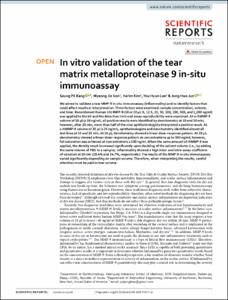In vitro validation of the tear matrix metalloproteinase 9 in-situ immunoassay
- Keimyung Author(s)
- Lee, You Hyun; Jun, Jong Hwa
- Department
- Dept. of Ophthalmology (안과학)
- Journal Title
- Scientific Reports
- Issued Date
- 2020
- Volume
- 10
- Issue
- 1
- Abstract
- We aimed to validate a tear MMP-9 in-situ immunoassay (InflammaDry) and to identify factors that could affect results or interpretation. Three factors were examined: sample concentration, volume, and time. Recombinant human (rh) MMP-9 (10 or 20 μl; 0, 12.5, 25, 50, 100, 200, 500, and 1,000 ng/ml) was applied to the kit and the detection limit and assay reproducibility were examined. At a rhMMP-9 volume of 10 μl (≥ 50 ng/ml), all positive results were identified by densitometry at 10 and 20 min; however, after 20 min, more than half of the nine ophthalmologists interpreted a positive result. At a rhMMP-9 volume of 20 μl (≥ 25 ng/ml), ophthalmologists and densitometry identified almost all test lines at 10 and 20 min. At 10 μl, densitometry showed a linear dose-response pattern. At 20 μl, densitometry showed a linear dose-response pattern at concentrations up to 500 ng/ml; however, full saturation was achieved at concentrations ≥ 500 ng/ml. When the same amount of rhMMP-9 was applied, the density result increased significantly upon doubling of the solvent volume (i.e., by adding the same volume of PBS to a sample). InflammaDry showed a high inter- and intra-assay coefficient of variation at 10 min (28.4% and 24.7%, respectively). The results of the MMP-9 in-situ immunoassay varied significantly depending on sample volume. Therefore, when interpreting the results, careful attention must be paid to tear volume.
- Publisher
- School of Medicine (의과대학)
- Citation
- Seung Pil Bang et al. (2020). In vitro validation of the tear matrix metalloproteinase 9 in-situ immunoassay. Scientific Reports, 10(1), 15126. doi: 10.1038/s41598-020-71977-w
- Type
- Article
- ISSN
- 2045-2322
- Source
- https://www.nature.com/articles/s41598-020-71977-w
- Appears in Collections:
- 1. School of Medicine (의과대학) > Dept. of Ophthalmology (안과학)
- 파일 목록
-
-
Download
 oak-2020-0557.pdf
기타 데이터 / 6.5 MB / Adobe PDF
oak-2020-0557.pdf
기타 데이터 / 6.5 MB / Adobe PDF
-
Items in Repository are protected by copyright, with all rights reserved, unless otherwise indicated.